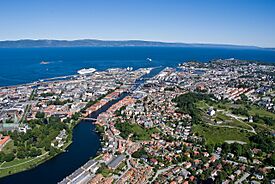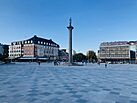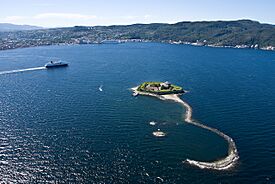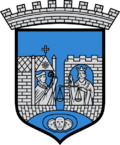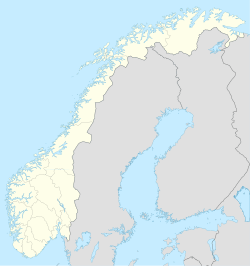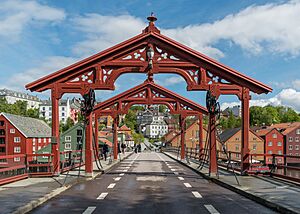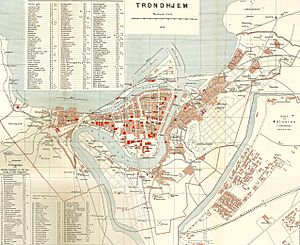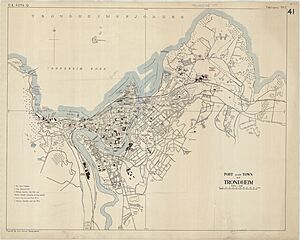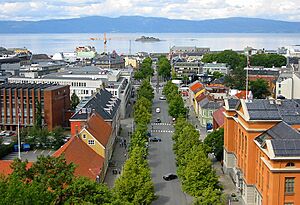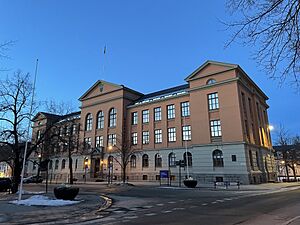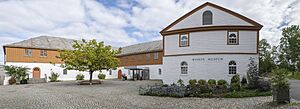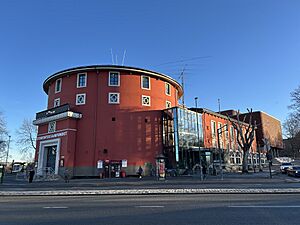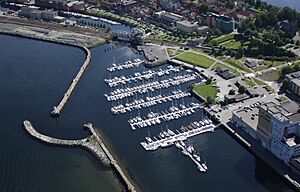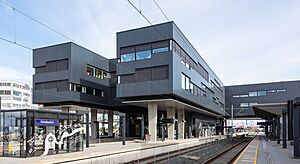Trondheim facts for kids
Quick facts for kids
Trondheim
Tråante
|
|||
|---|---|---|---|
|
City
|
|||
|
From the top: Outer city with Nidelva and sea port, Nidelva seen from Øya, Bakklandet, The city's central square (Torvet), Old Town Bridge, Munkholmen seen from the air
|
|||
|
|||
| Nickname(s):
Stiftstaden
(English: "The Diocese City") |
|||
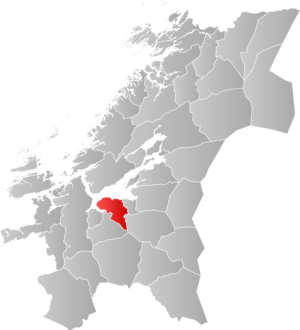
Location of the municipality
|
|||
| Country | Norway | ||
| Municipality | Trondheim | ||
| County | Trøndelag | ||
| District | Trondheim Region | ||
| Official language | Bokmål | ||
| Established | 997 | ||
| Area | |||
| • City | 321.81 km2 (124.25 sq mi) | ||
| • Urban | 342.30 km2 (132.16 sq mi) | ||
| • Metro | 7,295 km2 (2,817 sq mi) | ||
| Population
(31 December 2022)
|
|||
| • City | 212,660 | ||
| • Density | 660.825/km2 (1,711.53/sq mi) | ||
| • Urban | 186,364 | ||
| • Urban density | 544.446/km2 (1,410.110/sq mi) | ||
| • Metro | 279,234 | ||
| • Metro density | 38.2775/km2 (99.138/sq mi) | ||
| • Municipality/Urban rank | 3rd/4th | ||
| • Metro rank | 4th | ||
| Time zone | UTC+02:00 (CET) | ||
| • Summer (DST) | CEST | ||
| Historical population | ||
|---|---|---|
| Year | Pop. | ±% |
| 1769 | 11,315 | — |
| 1951 | 56,582 | +400.1% |
| 1960 | 59,286 | +4.8% |
| 1970 | 126,190 | +112.8% |
| 1980 | 134,726 | +6.8% |
| 1990 | 137,346 | +1.9% |
| 2000 | 148,859 | +8.4% |
| 2010 | 171,540 | +15.2% |
| 2014 | 183,960 | +7.2% |
| 2022 | 211,106 | +14.8% |
| Source: Statistics Norway | ||
Trondheim is a city and municipality in Trøndelag county, Norway. As of 2022, it had a population of 212,660 people. Trondheim is the third largest municipality in Norway and the fourth largest urban area. It is located on the south shore of Trondheim Fjord, where the Nidelva River meets the sea.
Trondheim is home to important technology and science places. These include the Norwegian University of Science and Technology (NTNU), the Foundation for Scientific and Industrial Research (SINTEF), the Geological Survey of Norway (NGU), and St. Olavs University Hospital.
The city was started in 997 as a trading post. It was the capital of Norway from the Viking Age until 1217. From 1152 to 1537, it was the main city for the Catholic Archdiocese of Nidaros. After that, it became the center for the Lutheran Diocese of Nidaros and is home to the famous Nidaros Cathedral. Trondheim became an official municipality in 1838. The current municipality was formed in 1964 when several smaller areas joined Trondheim. It grew even more in 2020 when Klæbu Municipality merged with it.
Trondheim has a mild climate for being so far north. Summers are moderate, and winters often stay above freezing near the coast. Higher areas can be colder and have more snow. The city is the seat of the County Mayor of Trøndelag county.
Trondheim is also known for sports. It is home to football club Rosenborg, Norway's most successful football team. The Granåsen Ski Centre has hosted big international skiing events.
Contents
- City Names and Their Meanings
- A Look at Trondheim's Past
- Trondheim's Geography and Climate
- City Life and Places to See
- How Trondheim is Governed
- Learning and Research in Trondheim
- Media and Communication
- Trondheim's Culture Scene
- Sports and Fun Activities
- Getting Around Trondheim
- Sister Cities
- Notable People from Trondheim
- Images for kids
- See also
City Names and Their Meanings

The city was founded in 997 by Olav Tryggvason. It was first called Nidaros. This name came from the local river Nid and the Old Norse word óss, meaning "river mouth". So, Nidaros meant "the outlet of the Nid River".
People also commonly called the city kaupangr, which means "city" or "marketplace". More specifically, it was called kaupangr í Þróndheimi, meaning "the city in Trondheim". Trondheim was the old name for the whole region now known as Trøndelag. This region was where the people called Trønder lived. The name Trondheim meant "the home of the Trønder people".
Over time, the city's name was shortened to Þróndheimr. Later, it became Trondhjem because of the Dano-Norwegian spelling, as Norway was part of Denmark-Norway for many centuries.
In 1917, Norway started changing city names to make them sound more Norwegian and less Danish. In 1928, people in Trondhjem voted on whether to change the city's name back to Nidaros. Most people voted to keep Trondhjem. However, the Norwegian Parliament decided in 1929 to change the city's name to Nidaros starting January 1, 1930. This caused a lot of public anger and even riots. Because of this, the Parliament changed the name again on March 6, 1931, to Trondheim, using the older Norwegian spelling. The cathedral and diocese kept the name Nidaros.
During Second World War, Trondheim was briefly called Drontheim by the Germans.
A Look at Trondheim's Past
Trondheim was founded in 997 CE by Viking King Olav Tryggvason. He called it Kaupangen, meaning "market or trading place". Soon after, it was known as Nidaros. It was often used as the king's home and was Norway's capital until 1217.
People have lived in this area for thousands of years. Ancient kings of Norway were honored in Trondheim at Øretinget, a special meeting place by the Nidelva River. Harald Fairhair and his son, Haakon I, were hailed as kings here. A battle called Kalvskinnet happened in Trondheim in 1179. King Sverre Sigurdsson and his warriors won against Erling Skakke.
From 1152, Trondheim was the center for the Archbishop of Nidaros for Norway. The Archbishop worked from the Archbishop's Palace. When Lutheran Protestantism was introduced in 1537, the last archbishop, Olav Engelbrektsson, had to leave the city.
From the 16th to the 19th centuries, many fires damaged the city because most buildings were made of wood. After a big fire in 1681, the city was rebuilt almost completely. General Johan Caspar von Cicignon from Luxembourg planned new, wide streets like Munkegata. This was done to stop future fires from spreading so easily. At that time, fewer than 10,000 people lived in the city.
In 1658, Trondheim and the rest of Trøndelag became Swedish territory for a short time. But after a three-month siege, Norway took the area back ten months later. This conflict ended with the Treaty of Copenhagen in 1660.
During the Second World War, Nazi Germany occupied Trondheim from April 9, 1940, until May 8, 1945. The German forces took over the city without much resistance. They turned Trondheim into a major base for submarines, building a large bunker called DORA I. The Germans also planned to build a huge new city for 300,000 people called Nordstern ("Northern Star") near Trondheim. This project was started but not finished when the war ended.
How Trondheim Grew: Municipal History
The city of Trondheim was officially formed on January 1, 1838. Over the years, it grew by merging with nearby areas.
- On January 1, 1864, part of Strinda Municipality joined Trondheim.
- More of Strinda Municipality was added in 1893 and 1952.
- On January 1, 1964, a big merger happened. Leinstrand Municipality, Byneset Municipality, Strinda Municipality, and Tiller Municipality all joined Trondheim. This almost doubled the city's population.
- On January 1, 2020, Klæbu Municipality also merged with Trondheim.
Trondheim's Coat of Arms
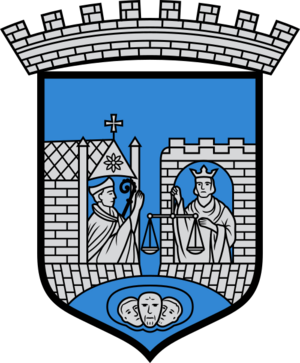
Trondheim's coat of arms is very old, dating back to the 13th century. It shows an archbishop on the left and a crowned king on the right. These two figures represent the balance of power between the church and the king, which was important in the 1200s.
Below them are three male heads. These heads symbolize the city's importance as Norway's first capital and the archbishop's home. The design used today was created by Håkon Thorsen in 1897.
Trondheim's Geography and Climate
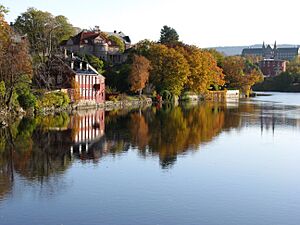
Trondheim is located where the Nidelva River flows into Trondheim Fjord. This spot provides a great harbor and sheltered conditions. In the Middle Ages, the river was deep enough for most boats. However, a mudslide in the 1600s made it harder to navigate.
The highest point in the municipality is Storheia hill, which is 565 meters above sea level. In summer, the sun rises very early (3:00 AM) and sets very late (11:40 PM). Between May 23 and July 19, it stays light enough outside all night if the sky is clear. In winter, the sun rises late (10:01 AM) and sets early (2:31 PM), staying very low in the sky.
Trondheim's Weather
Trondheim has a mild climate for its northern location. It is mostly protected from strong winds from the south and southwest. However, it can get strong northwesterly winds. The weather can change a lot depending on whether there is high or low pressure. High pressure brings sunny weather, while low pressure from the Atlantic can bring weeks of rain.
Trondheim usually gets moderate snowfall from November to March. But this is often mixed with mild weather and rain. There are about 14 days each winter with at least 25 cm of snow. Higher areas in the suburbs, like Bymarka, often have more snow and good skiing conditions.
The warmest month on record was July 2014, with an average temperature of 19.5°C. The coldest month on record was February 1966, with an average of -9.9°C. The city usually has about 160 days without frost.
City Life and Places to See
Trondheim's city center has many small, unique shops. The main shopping streets are Nordre gate, Olav Tryggvasons gate, and Thomas Angells gate. You can find everything from old, traditional stores to new, trendy ones.
The Nedre Elvehavn area, once a shipbuilding site, was rebuilt in the 1990s. Old industrial buildings were replaced with homes and a shopping center called Solsiden (The Sunny Side). This is a popular place for young people to live and shop.
Larger shopping malls are in the eastern suburb of Lade and the southern suburb of Tiller. Big Swedish store chains like IKEA are also found here.
DORA 1 is a former German submarine base from the Second World War. Today, it holds various archives, including the city's historical records. It is also used as a concert venue.
Kristiansten Fortress, built from 1681 to 1684, sits on a hill east of Trondheim. It helped defend the city from the Swedes in 1718.
A statue of Olav Tryggvason, who founded Trondheim, stands in the city's central square. It is on top of a tall stone pillar. The base of the statue is also a sun dial.
The small island of Munkholmen is a popular spot for tourists and recreation. This island has been used as a place for executions, a monastery, a fortress, a prison, and a gun station during the Second World War.
Stiftsgården is the royal residence in Trondheim. It was built in 1774 and is one of the largest wooden buildings in Northern Europe. Royals and their guests have used it since 1800.
A statue of Leif Ericson is located by the sea, near the old Customs Building. This statue is a copy of one in Seattle.
Nidaros Cathedral: A Historic Landmark
The Nidaros Cathedral and the Archbishop's Palace are right next to each other in the city center. The cathedral, started in 1070, is Norway's most important Gothic building. In the Middle Ages, it was a very important Christian pilgrimage site in Northern Europe. Today, it is the northernmost medieval cathedral in the world and the second largest in Scandinavia.
For centuries, the Nidaros Cathedral was where Norwegian kings were crowned. King Haakon VII was the last king crowned there in 1906. Since King Olav V in 1957, kings are no longer crowned but are blessed in the cathedral. In 1991, King Harald V and Queen Sonja were blessed there.
The Pilgrim's Route (Pilegrimsleden) to Saint Olav's tomb at Nidaros Cathedral has been reopened. This main route is about 640 km long. It starts in Oslo and goes north to Trondheim. There are offices to help pilgrims along the way.
Other Churches in Trondheim
The Lutheran Church of Norway has 21 churches in Trondheim. They are all part of the Diocese of Nidaros, which is based at the Nidaros Cathedral. Many of these churches are hundreds of years old.
| Deanery (Prosti) |
Parish (Sokn) |
Church name | Year built | Location |
|---|---|---|---|---|
| Nidaros | Nidaros Domkirke og Vår Frue | Nidaros Cathedral | 1070–1300 | Midtbyen |
| Vår Frue Church | 1200 | Midtbyen | ||
| Bakklandet | Bakke Church | 1715 | Bakklandet | |
| Lade | Lade Church | 1190 | Lade | |
| Lademoen | Lademoen Church | 1905 | Lademoen | |
| Byåsen | Byåsen | Byåsen Church | 1974 | Byåsen |
| Ilen | Ilen Church | 1889 | Ila | |
| Sverresborg | Havstein Church | 1857 | Sverresborg | |
| Heimdal | Byneset | Byneset Church | 1180 | Byneset |
| Heimdal | Heimdal Church | 1960 | Heimdal | |
| Kolstad | Kolstad Church | 1986 | Kolstad | |
| Leinstrand | Leinstrand Church | 1673 | Nypan | |
| Tiller | Tiller Church | 1901 | Tiller | |
| Strinda | Berg | Berg Church | 1972 | Berg |
| Bratsberg | Bratsberg Church | 1850 | Bratsberg | |
| Charlottenlund | Charlottenlund Church | 1973 | Charlottenlund | |
| Hoeggen | Hoeggen Church | 1997 | Lerkendal | |
| Ranheim | Ranheim Church | 1933 | Ranheim | |
| Strinda | Strinda Church | 1900 | Strinda | |
| Strindheim | Strindheim Church | 1979 | Strindheim | |
| Tempe | Tempe Church | 1960 | Lerkendal |
The Roman Catholic Sankt Olav domkirke is the main church for Catholics in Trondheim. It is located across the street from the Nidaros Cathedral.
Museums to Explore
Sverresborg, also called Zion, is an open-air museum with over 60 buildings. It was originally a fort built by Sverre Sigurdsson in 1182–1183.
The Trondheim Science Center (Vitensenteret i Trondheim) is a hands-on science museum. The NTNU University Museum is part of the Norwegian University of Science and Technology. There are also smaller museums like the Trondheim Maritime Museum, the Armoury, Kristiansten Fortress, and the Ringve National Museum for music.
Rockheim is Norway's national museum for popular music. It opened in 2010 and is known for its unique roof that changes colors at night.
Prisons in Trondheim
Vollan District Jail (Vollan kretsfengsel) was a jail used during the nazi occupation of Norway. It held both prisoners of war and criminals. Many prisoners from Vollan were taken to Kristiansten Fortress and shot. The jail closed in 1971.
Trondheim Prison (Trondheim fengsel) is a modern prison that can hold 184 inmates. It has different sections, including a closed department, an open division, and a halfway house in downtown Trondheim.
Trondheim's Wider Urban Area
Trondheim is the main city in the Trondheim Region. Many people from nearby towns come to Trondheim for work, shopping, and healthcare. The area where people commonly commute to Trondheim includes Malvik, downtown Stjørdal, downtown Melhus, Skaun, and parts of Vanvikan in Indre Fosen.
How Trondheim is Governed
Trondheim Municipality is in charge of many important services for its citizens. This includes primary education (up to 10th grade), local health services, services for senior citizens, and other social services. The municipality also handles zoning, economic development, and local roads.
The municipality is run by a municipal council made up of 67 elected representatives. The mayor is chosen by the municipal council.
On January 1, 2005, the city was reorganized into four main areas called boroughs. These boroughs are Midtbyen, Østbyen, Lerkendal, and Heimdal. Each borough has its own social services offices.
The Municipal Council
The city council (Bystyret) of Trondheim has 67 members who are elected for four-year terms. Before 2011, there were 85 council members, but this number was reduced. The tables below show how the council has been made up of different political parties over the years.
| Party name (in Norwegian) | Number of representatives |
|
|---|---|---|
| Labour Party (Arbeiderpartiet) | 17 | |
| Progress Party (Fremskrittspartiet) | 4 | |
| Green Party (Miljøpartiet De Grønne) | 4 | |
| Conservative Party (Høyre) | 20 | |
| Industry and Business Party (Industri‑ og Næringspartiet) | 1 | |
| Christian Democratic Party (Kristelig Folkeparti) | 1 | |
| Pensioners' Party (Pensjonistpartiet) | 3 | |
| Red Party (Rødt) | 3 | |
| Centre Party (Senterpartiet) | 1 | |
| Socialist Left Party (Sosialistisk Venstreparti) | 9 | |
| Liberal Party (Venstre) | 4 | |
| Total number of members: | 67 | |
| Party name (in Norwegian) | Number of representatives |
|
|---|---|---|
| Labour Party (Arbeiderpartiet) | 17 | |
| Progress Party (Fremskrittspartiet) | 4 | |
| Green Party (Miljøpartiet De Grønne) | 7 | |
| Conservative Party (Høyre) | 14 | |
| Christian Democratic Party (Kristelig Folkeparti) | 1 | |
| Pensioners' Party (Pensjonistpartiet) | 3 | |
| Red Party (Rødt) | 5 | |
| Centre Party (Senterpartiet) | 5 | |
| Socialist Left Party (Sosialistisk Venstreparti) | 8 | |
| Liberal Party (Venstre) | 3 | |
| Total number of members: | 67 | |
| Party name (in Norwegian) | Number of representatives |
|
|---|---|---|
| Labour Party (Arbeiderpartiet) | 28 | |
| Progress Party (Fremskrittspartiet) | 4 | |
| Green Party (Miljøpartiet De Grønne) | 5 | |
| Conservative Party (Høyre) | 14 | |
| Christian Democratic Party (Kristelig Folkeparti) | 2 | |
| Pensioners' Party (Pensjonistpartiet) | 2 | |
| Red Party (Rødt) | 2 | |
| Centre Party (Senterpartiet) | 2 | |
| Socialist Left Party (Sosialistisk Venstreparti) | 4 | |
| Liberal Party (Venstre) | 4 | |
| Total number of members: | 67 | |
| Party name (in Norwegian) | Number of representatives |
|
|---|---|---|
| Labour Party (Arbeiderpartiet) | 27 | |
| Progress Party (Fremskrittspartiet) | 6 | |
| Green Party (Miljøpartiet De Grønne) | 2 | |
| Conservative Party (Høyre) | 18 | |
| Christian Democratic Party (Kristelig Folkeparti) | 2 | |
| Pensioners' Party (Pensjonistpartiet) | 1 | |
| Red Party (Rødt) | 2 | |
| Centre Party (Senterpartiet) | 1 | |
| Socialist Left Party (Sosialistisk Venstreparti) | 4 | |
| Liberal Party (Venstre) | 4 | |
| Total number of members: | 67 | |
| Party name (in Norwegian) | Number of representatives |
|
|---|---|---|
| Labour Party (Arbeiderpartiet) | 37 | |
| Progress Party (Fremskrittspartiet) | 13 | |
| Green Party (Miljøpartiet De Grønne) | 2 | |
| Conservative Party (Høyre) | 13 | |
| Christian Democratic Party (Kristelig Folkeparti) | 3 | |
| The Democrats (Demokratene) | 1 | |
| Pensioners' Party (Pensjonistpartiet) | 1 | |
| Red Electoral Alliance (Rød Valgallianse) | 3 | |
| Centre Party (Senterpartiet) | 2 | |
| Socialist Left Party (Sosialistisk Venstreparti) | 7 | |
| Liberal Party (Venstre) | 3 | |
| Total number of members: | 85 | |
| Party name (in Norwegian) | Number of representatives |
|
|---|---|---|
| Labour Party (Arbeiderpartiet) | 26 | |
| Progress Party (Fremskrittspartiet) | 10 | |
| Green Party (Miljøpartiet De Grønne) | 1 | |
| Conservative Party (Høyre) | 18 | |
| Christian Democratic Party (Kristelig Folkeparti) | 3 | |
| The Democrats (Demokratene) | 1 | |
| Pensioners' Party (Pensjonistpartiet) | 4 | |
| Red Electoral Alliance (Rød Valgallianse) | 2 | |
| Centre Party (Senterpartiet) | 3 | |
| Socialist Left Party (Sosialistisk Venstreparti) | 15 | |
| Liberal Party (Venstre) | 2 | |
| Total number of members: | 85 | |
| Party name (in Norwegian) | Number of representatives |
|
|---|---|---|
| Labour Party (Arbeiderpartiet) | 26 | |
| Progress Party (Fremskrittspartiet) | 7 | |
| Green Party (Miljøpartiet De Grønne) | 1 | |
| Conservative Party (Høyre) | 30 | |
| Pensioners' Party (Pensjonistpartiet) | 1 | |
| Red Electoral Alliance (Rød Valgallianse) | 3 | |
| Centre Party (Senterpartiet) | 1 | |
| Socialist Left Party (Sosialistisk Venstreparti) | 8 | |
| Liberal Party (Venstre) | 3 | |
| City list (Bylista) | 1 | |
| Total number of members: | 85 | |
| Party name (in Norwegian) | Number of representatives |
|
|---|---|---|
| Labour Party (Arbeiderpartiet) | 22 | |
| Progress Party (Fremskrittspartiet) | 6 | |
| Green Party (Miljøpartiet De Grønne) | 1 | |
| Conservative Party (Høyre) | 36 | |
| Christian Democratic Party (Kristelig Folkeparti) | 4 | |
| Red Electoral Alliance (Rød Valgallianse) | 2 | |
| Centre Party (Senterpartiet) | 3 | |
| Socialist Left Party (Sosialistisk Venstreparti) | 5 | |
| Liberal Party (Venstre) | 3 | |
| City list (Bylista) | 3 | |
| Total number of members: | 85 | |
| Party name (in Norwegian) | Number of representatives |
|
|---|---|---|
| Labour Party (Arbeiderpartiet) | 22 | |
| Progress Party (Fremskrittspartiet) | 4 | |
| Green Party (Miljøpartiet De Grønne) | 1 | |
| Conservative Party (Høyre) | 29 | |
| Christian Democratic Party (Kristelig Folkeparti) | 4 | |
| Red Electoral Alliance (Rød Valgallianse) | 2 | |
| Centre Party (Senterpartiet) | 5 | |
| Socialist Left Party (Sosialistisk Venstreparti) | 12 | |
| Liberal Party (Venstre) | 2 | |
| City List (Bylista) | 4 | |
| Total number of members: | 85 | |
| Party name (in Norwegian) | Number of representatives |
|
|---|---|---|
| Labour Party (Arbeiderpartiet) | 31 | |
| Progress Party (Fremskrittspartiet) | 11 | |
| Conservative Party (Høyre) | 21 | |
| Christian Democratic Party (Kristelig Folkeparti) | 4 | |
| Red Electoral Alliance (Rød Valgallianse) | 2 | |
| Centre Party (Senterpartiet) | 2 | |
| Socialist Left Party (Sosialistisk Venstreparti) | 5 | |
| Liberal Party (Venstre) | 3 | |
| City List (Bylista) | 6 | |
| Total number of members: | 85 | |
| Party name (in Norwegian) | Number of representatives |
|
|---|---|---|
| Labour Party (Arbeiderpartiet) | 35 | |
| Progress Party (Fremskrittspartiet) | 5 | |
| Conservative Party (Høyre) | 28 | |
| Christian Democratic Party (Kristelig Folkeparti) | 4 | |
| Red Electoral Alliance (Rød Valgallianse) | 2 | |
| Centre Party (Senterpartiet) | 2 | |
| Socialist Left Party (Sosialistisk Venstreparti) | 6 | |
| Liberal Party (Venstre) | 3 | |
| Total number of members: | 85 | |
| Party name (in Norwegian) | Number of representatives |
|
|---|---|---|
| Labour Party (Arbeiderpartiet) | 36 | |
| Progress Party (Fremskrittspartiet) | 1 | |
| Conservative Party (Høyre) | 30 | |
| Christian Democratic Party (Kristelig Folkeparti) | 5 | |
| Red Electoral Alliance (Rød Valgallianse) | 1 | |
| Centre Party (Senterpartiet) | 3 | |
| Socialist Left Party (Sosialistisk Venstreparti) | 5 | |
| Liberal Party (Venstre) | 4 | |
| Total number of members: | 85 | |
| Party name (in Norwegian) | Number of representatives |
|
|---|---|---|
| Labour Party (Arbeiderpartiet) | 34 | |
| Conservative Party (Høyre) | 24 | |
| Christian Democratic Party (Kristelig Folkeparti) | 8 | |
| New People's Party (Nye Folkepartiet) | 2 | |
| Red Electoral Alliance (Rød Valgallianse) | 1 | |
| Centre Party (Senterpartiet) | 6 | |
| Socialist Left Party (Sosialistisk Venstreparti) | 7 | |
| Liberal Party (Venstre) | 3 | |
| Total number of members: | 85 | |
| Party name (in Norwegian) | Number of representatives |
|
|---|---|---|
| Labour Party (Arbeiderpartiet) | 40 | |
| Conservative Party (Høyre) | 19 | |
| Communist Party (Kommunistiske Parti) | 2 | |
| Christian Democratic Party (Kristelig Folkeparti) | 6 | |
| Centre Party (Senterpartiet) | 6 | |
| Socialist People's Party (Sosialistisk Folkeparti) | 7 | |
| Liberal Party (Venstre) | 5 | |
| Total number of members: | 85 | |
| Party name (in Norwegian) | Number of representatives |
|
|---|---|---|
| Labour Party (Arbeiderpartiet) | 43 | |
| Conservative Party (Høyre) | 22 | |
| Communist Party (Kommunistiske Parti) | 1 | |
| Christian Democratic Party (Kristelig Folkeparti) | 4 | |
| Centre Party (Senterpartiet) | 3 | |
| Socialist People's Party (Sosialistisk Folkeparti) | 7 | |
| Liberal Party (Venstre) | 5 | |
| Total number of members: | 85 | |
| Party name (in Norwegian) | Number of representatives |
|
|---|---|---|
| Labour Party (Arbeiderpartiet) | 45 | |
| Conservative Party (Høyre) | 23 | |
| Communist Party (Kommunistiske Parti) | 3 | |
| Christian Democratic Party (Kristelig Folkeparti) | 5 | |
| Centre Party (Senterpartiet) | 3 | |
| Socialist People's Party (Sosialistisk Folkeparti) | 3 | |
| Liberal Party (Venstre) | 3 | |
| Total number of members: | 85 | |
| Party name (in Norwegian) | Number of representatives |
|
|---|---|---|
| Labour Party (Arbeiderpartiet) | 41 | |
| Conservative Party (Høyre) | 21 | |
| Communist Party (Kommunistiske Parti) | 6 | |
| Christian Democratic Party (Kristelig Folkeparti) | 5 | |
| Centre Party (Senterpartiet) | 1 | |
| Liberal Party (Venstre) | 3 | |
| Total number of members: | 77 | |
| Party name (in Norwegian) | Number of representatives |
|
|---|---|---|
| Labour Party (Arbeiderpartiet) | 38 | |
| Conservative Party (Høyre) | 21 | |
| Communist Party (Kommunistiske Parti) | 9 | |
| Christian Democratic Party (Kristelig Folkeparti) | 6 | |
| Liberal Party (Venstre) | 3 | |
| Total number of members: | 77 | |
| Party name (in Norwegian) | Number of representatives |
|
|---|---|---|
| Labour Party (Arbeiderpartiet) | 36 | |
| Conservative Party (Høyre) | 20 | |
| Communist Party (Kommunistiske Parti) | 10 | |
| Christian Democratic Party (Kristelig Folkeparti) | 6 | |
| Liberal Party (Venstre) | 4 | |
| Total number of members: | 76 | |
| Party name (in Norwegian) | Number of representatives |
|
|---|---|---|
| Labour Party (Arbeiderpartiet) | 31 | |
| Conservative Party (Høyre) | 19 | |
| Communist Party (Kommunistiske Parti) | 15 | |
| Christian Democratic Party (Kristelig Folkeparti) | 5 | |
| Liberal Party (Venstre) | 6 | |
| Total number of members: | 76 | |
| Party name (in Norwegian) | Number of representatives |
|
|---|---|---|
| Labour Party (Arbeiderpartiet) | 30 | |
| Conservative Party (Høyre) | 14 | |
| Communist Party (Kommunistiske Parti) | 18 | |
| Christian Democratic Party (Kristelig Folkeparti) | 9 | |
| Liberal Party (Venstre) | 5 | |
| Total number of members: | 76 | |
| Party name (in Norwegian) | Number of representatives |
|
|---|---|---|
| Labour Party (Arbeiderpartiet) | 33 | |
| Free-minded People's Party (Frisinnede Folkeparti) | 11 | |
| Conservative Party (Høyre) | 21 | |
| Communist Party (Kommunistiske Parti) | 8 | |
| Liberal Party (Venstre) | 3 | |
| Total number of members: | 76 | |
| Note: Due to the German occupation of Norway during World War II, no elections were held for new municipal councils until after the war ended in 1945. | ||
| Party name (in Norwegian) | Number of representatives |
|
|---|---|---|
| Labour Party (Arbeiderpartiet) | 29 | |
| Free-minded People's Party (Frisinnede Folkeparti) | 16 | |
| Conservative Party (Høyre) | 18 | |
| Communist Party (Kommunistiske Parti) | 8 | |
| Liberal Party (Venstre) | 4 | |
| Local List(s) (Lokale lister) | 1 | |
| Total number of members: | 76 | |
| Party name (in Norwegian) | Number of representatives |
|
|---|---|---|
| Labour Party (Arbeiderpartiet) | 24 | |
| Temperance Party (Avholdspartiet) | 2 | |
| Free-minded People's Party (Frisinnede Folkeparti) | 11 | |
| Conservative Party (Høyre) | 22 | |
| Communist Party (Kommunistiske Parti) | 10 | |
| Liberal Party (Venstre) | 3 | |
| Joint List(s) of Non-Socialist Parties (Borgerlige Felleslister) | 4 | |
| Total number of members: | 76 | |
| Party name (in Norwegian) | Number of representatives |
|
|---|---|---|
| Labour Party (Arbeiderpartiet) | 28 | |
| Temperance Party (Avholdspartiet) | 4 | |
| Free-minded Liberal Party (Frisinnede Venstre) | 9 | |
| Conservative Party (Høyre) | 22 | |
| Communist Party (Kommunistiske Parti) | 9 | |
| Liberal Party (Venstre) | 4 | |
| Total number of members: | 76 | |
| Party name (in Norwegian) | Number of representatives |
|
|---|---|---|
| Labour Party (Arbeiderpartiet) | 18 | |
| Temperance Party (Avholdspartiet) | 3 | |
| Free-minded Liberal Party (Frisinnede Venstre) | 9 | |
| Conservative Party (Høyre) | 21 | |
| Communist Party (Kommunistiske Parti) | 12 | |
| Social Democratic Labour Party (Socialdemokratiske Arbeiderparti) |
4 | |
| Liberal Party (Venstre) | 5 | |
| Workers' Common List (Arbeidernes fellesliste) | 4 | |
| Total number of members: | 76 | |
| Party name (in Norwegian) | Number of representatives |
|
|---|---|---|
| Labour Party (Arbeiderpartiet) | 28 | |
| Free-minded Liberal Party (Frisinnede Venstre) | 9 | |
| Conservative Party (Høyre) | 18 | |
| Social Democratic Labour Party (Socialdemokratiske Arbeiderparti) |
7 | |
| Liberal Party (Venstre) | 5 | |
| Local List(s) (Lokale lister) | 9 | |
| Total number of members: | 76 | |
| Party name (in Norwegian) | Number of representatives |
|
|---|---|---|
| Labour Party (Arbeiderpartiet) | 22 | |
| Temperance Party (Avholdspartiet) | 5 | |
| Free-minded Liberal Party (Frisinnede Venstre) | 8 | |
| Conservative Party (Høyre) | 22 | |
| Liberal Party (Venstre) | 4 | |
| Local List(s) (Lokale lister) | 7 | |
| Total number of members: | 68 | |
| Party name (in Norwegian) | Number of representatives |
|
|---|---|---|
| Labour Party (Arbeiderpartiet) | 32 | |
| Free-minded Liberal Party (Frisinnede Venstre) | 6 | |
| Conservative Party (Høyre) | 20 | |
| Liberal Party (Venstre) | 7 | |
| Joint list of the Conservative Party (Høyre) and the Free-minded Liberal Party (Frisinnede Venstre) | 3 | |
| Total number of members: | 68 | |
| Party name (in Norwegian) | Number of representatives |
|
|---|---|---|
| Labour Party (Arbeiderpartiet) | 26 | |
| Temperance Party (Avholdspartiet) | 3 | |
| Free-minded Liberal Party (Frisinnede Venstre) | 8 | |
| Conservative Party (Høyre) | 21 | |
| Liberal Party (Venstre) | 10 | |
| Total number of members: | 68 | |
Learning and Research in Trondheim
Trondheim is a major center for education and research. It is home to the Norwegian University of Science and Technology (NTNU), which has many technical labs. There is also BI-Trondheim, a campus for the Norwegian Business School. Both universities welcome many international students.
St. Olavs University Hospital is a large hospital in downtown Trondheim. It is a teaching hospital that works closely with NTNU on research and medical education.
SINTEF is a big independent research organization in Scandinavia. Most of its 1,800 employees work in Trondheim. The Air Force Academy of the Royal Norwegian Air Force is also located here.
The Geological Survey of Norway is in Trondheim. It is a major science institution with many scientists.
The city has 11 high schools. Trondheim katedralskole ("Trondheim Cathedral School") was founded in 1152 and is Norway's oldest high school. Charlottenlund videregående skole is the largest in Sør-Trøndelag. Ila skole, founded in 1770, is the oldest primary school in Trondheim.
Media and Communication
Adresseavisen is the largest regional newspaper in Trondheim. It is also the oldest active newspaper in Norway, started in 1767. The Norwegian Broadcasting Corporation (NRK) has one of its two main offices in Trondheim.
The student community in Trondheim has its own media. Under Dusken is the student newspaper, Radio Revolt is the student radio station, and Student-TV broadcasts videos online.
Trondheim's Culture Scene
Visual Arts
The Trondheim Art Museum has Norway's third largest public art collection. It mainly features Norwegian art from the last 150 years.
The National Museum of Decorative Arts and Design has a large collection of decorative arts and design. This includes many tapestries by Norwegian artist Hannah Ryggen. It also has Norway's only permanent exhibit of Japanese arts and crafts.
Trøndelag senter for samtidskunst (Trøndelag Centre for Contemporary Art, TSSK) was started in 1976. There are also two artist-run spaces: Galleri Blunk and Babel.
Kunsthall Trondheim opened in 2016. The PoMo Museum, which focuses on modern and contemporary art, opened in February 2025.
Stage Performances
The main regional theater, Trøndelag Teater, is in Trondheim. Built in 1816, it is the oldest theater still in use in Scandinavia. The city also has an alternative theater called Teaterhuset Avant Garden.
Music in Trondheim
Trondheim has a lively music scene, especially for rock, jazz, and classical music. The music conservatory at NTNU is known for being very creative. The Trondheim Symphony Orchestra and the Trondheim Soloists are well-known groups. The city hosts a yearly Jazz festival and is home to the Trondheim Jazz Orchestra.
Famous classical musicians from Trondheim include violinist Arve Tellefsen and the Nidaros Cathedral Boys' Choir. Thomas Bergersen, a composer known for his work with Two Steps From Hell, was born in Trondheim.
Pop and rock artists from Trondheim include Åge Aleksandersen, Margaret Berger, DumDum Boys, and Motorpsycho. Rockheim, the national museum of popular music, is also located in Trondheim.
Film Scene
Trondheim has an active film scene with three film festivals: Minimalen Short Film Fest, Kosmorama International Film Fest, and Trondheim Documentarfestival. The city has two cinemas, Prinsen Kino and Nova kino.
Student Life
Students make up almost a fifth of Trondheim's population, so student culture is very important. The most famous student place is Studentersamfundet i Trondhjem, the city's student society. Its round, red building from 1929 is a landmark. NTNU, Norway's largest university, has about 36,000 students.
Student life in Trondheim is known for its volunteer work. The student society, for example, is run by over 1,200 volunteers. Students also organize two major Norwegian festivals: UKA and The International Student Festival in Trondheim (ISFiT).
Trondheim in Popular Culture
Trondheim is mentioned in the Monty Python album Another Monty Python Record with a funny dance called the Trondheim Hammer Dance. It is also a key location in the Command & Conquer: Tiberian Sun video game. The city of Tronjheim in The Inheritance Cycle books is likely inspired by Trondheim.
Sports and Fun Activities
Granåsen Ski Centre is a Nordic skiing venue in Byåsen. It often hosts World Cup competitions in ski jumping, biathlon, and cross-country skiing. It also hosted the 1997 and will host the 2025 FIS Nordic World Ski Championships.
You can go hiking and skiing around the city, especially in Bymarka, which you can reach by tram. Trondheim Golfklubb has a nine-hole golf course. Byneset Golfklubb has an 18-hole course.

Rosenborg BK is the city's top football club. They play at Lerkendal Stadion. They have won the Norwegian Premier League 26 times between 1967 and 2018. They have also played in the UEFA Champions League many times. Ranheim Fotball also plays in the top football leagues.
Byåsen IL plays in the women's handball league, and Kolstad Håndball plays in the men's handball league. They play their home games at Trondheim Spektrum or Kolstad Arena.
Trondheim is also considered the home of the basse game, which is played with a ball made of rubber bands.
Major Sports Teams
| Club | Sport | Founded | League | Venue |
|---|---|---|---|---|
| Rosenborg BK | Football | 1917 | Eliteserien (football) | Lerkendal stadion |
| Ranheim Fotball | Football | 1901 | OBOS-ligaen | EXTRA Arena |
| Byåsen | Handball (Women) | 1921 | Eliteserien (women's handball) | Kolstad Arena |
| Nidaros Hockey | Ice hockey | 2015 | 1. divisjon | Leangen Ishall |
| Rosenborg BK Kvinner | Football (women) | 1972 | Toppserien | Koteng Arena |
| Kolstad Håndball | Handball (men) | 1972 | Eliteserien (men's handball) | Kolstad Arena |
| Spektra Cricket | Cricket | 2014 | NCF Menn | Lade and Spektrum |
| Nidaros Jets | Basketball | 2014 | BLNO Menn | Husebyhallen |
Major Championships Hosted
| Event | Sport | Years | Venue |
|---|---|---|---|
| FIS Nordic World Ski Championships | Nordic skiing | 1997, 2025 | Granåsen |
| World Allround Speed Skating Championships | Speed skating | 1907, 1911, 1926, 1933, 1937 | Øya Stadion |
| IHF World Women's Handball Championship | Handball | 1993, 1999, 2023 | Trondheim Spektrum |
| IHF World Men's Handball Championship | Handball | 2025 | Trondheim Spektrum |
| European Men's Handball Championship | Handball | 2008, 2020 | Trondheim Spektrum |
| World Orienteering Championships | Orienteering | 2010 | Throughout Trondheim |
| UEFA Super Cup | Football | 2016 | Lerkendal Stadion |
Getting Around Trondheim
Trondheim has an international airport, Trondheim Airport, Værnes, located 32 km away in Stjørdal. It is Norway's fourth largest airport. You can fly directly from Værnes to cities like London, Amsterdam, Copenhagen, and Stockholm. The flight route between Trondheim and Oslo is one of the busiest in Europe.
Trondheim has the world's only bicycle lift, called Trampe.
Bus Travel
The bus system, run by AtB, covers most of the city and its suburbs. A new metro line system started on August 3, 2019. This new system covers the Trondheim area, including Malvik and Melhus. It makes bus travel more flexible, with buses running more often.
There is also a Nattbuss (Night Bus) service for those enjoying nightlife on weekends. Night buses have different, higher prices than regular buses.
Boats and Ferries
The Coastal Express ships (Hurtigruten) stop in Trondheim. Many cruise ships also visit during the summer. Every morning, Hurtigruten ships arrive and depart from Trondheim, both heading north and south.
Since 1994, there has been a fast boat service to Kristiansund. There is also a commuter boat service to Vanvikan. A car ferry route connects Trondheim with Fosen from the port of Flakk.
Train Connections
Major railway lines connect Trondheim to other parts of Norway and Sweden. The northbound Nordland Line goes north. The eastbound Meråker Line goes to Åre and Östersund in Sweden. There are two southbound lines to Oslo: the Røros Line and the Dovre Line.
Trondheim also has the northernmost tramway line in the world, the Gråkallen Line. This 8.8 km route runs from the city center, through the Byåsen district, and up to Lian in the recreation area Bymarka.
Roads Around Trondheim
Norway's longest road, the European route E6 motorway, passes through Trondheim. The eastern end of European route E39 is in Klett, just inside the municipality border. This road goes west towards Møre og Romsdal.
A newer road, National Road 706, also known as Nordre avlastningsvei, is an alternative route. It goes northwest through Ila and Piren before rejoining the E6.
Plans for new bridge projects over the Trondheim Fjord have been discussed, but construction has not started yet.
Sister Cities
Trondheim is twinned with several cities around the world:
 Darmstadt, Germany (1968)
Darmstadt, Germany (1968) Dunfermline, Scotland, United Kingdom (1945)
Dunfermline, Scotland, United Kingdom (1945) Graz, Austria (1968)
Graz, Austria (1968) Klaksvík, Faroe Islands (1987)
Klaksvík, Faroe Islands (1987) Kópavogur, Iceland (1946)
Kópavogur, Iceland (1946) Norrköping, Sweden (1946)
Norrköping, Sweden (1946) Odense, Denmark (1946)
Odense, Denmark (1946) Petah Tikva, Israel (1975)
Petah Tikva, Israel (1975) Ramallah, Palestine (2004)
Ramallah, Palestine (2004) Split, Croatia (1956)
Split, Croatia (1956) Tampere, Finland (1946)
Tampere, Finland (1946) Tiraspol, Moldova (1987)
Tiraspol, Moldova (1987) Vallejo, United States (1960)
Vallejo, United States (1960)
Notable People from Trondheim
Public Service and Thinkers
- Ove Bjelke (1611–1674) – a nobleman and important official.
- Albert Angell (1660–1705) – a landowner, businessman, and Mayor of Trondheim.
- Peter Tordenskiold (1691–1720) – a Dano-Norwegian naval officer.
- Frederik Due (1796–1873) – Norway's prime minister in Stockholm.
- John Lyng (1905–1978) – a politician who was briefly Prime Minister of Norway.
- Anne Margrethe Strømsheim (1914–2008) – a nurse and member of the Norwegian resistance during WWII.
- Erik Varden (born 1974) – the current Catholic Bishop of Trondheim.
Science and Education
- Hilchen Sommerschild (1756–1831) – a pioneer in education.
- Knut Schmidt-Nielsen (1915–2007) – an animal physiologist.
- Idun Reiten (born 1942) – a mathematician.
Artists and Performers
- Carl Lorck (1829–1882) – a Norwegian painter.
- Emmy Worm-Müller (1875–1950) – a silent film actress.
- Arne Eggen (1881–1955) – a classical composer and organist.
- Erling Viksjø (1910–1971) – an architect known for modern designs.
- Agnar Mykle (1915–1994) – a famous Norwegian author.
- Arve Tellefsen (born 1936) – a classical violinist.
- Liv Ullmann (born 1938) – a famous actress and director.
- Sidsel Endresen (born 1952) – a singer, composer, and actress.
- Thomas Bergersen (born 1980) – a composer and multi-instrumentalist.
- Georg Kajanus (born 1946) – a singer-songwriter and composer.
Sports Stars
- Hjalmar Andersen (1923–2013) – a speed skater who won three gold medals at the 1952 Winter Olympics.
- Arnfinn Bergmann (1928–2011) – a ski jumper who won gold at the 1952 Winter Olympics.
- Odd Iversen (1945–2014) – a footballer with many club appearances.
- Steffen Iversen (born 1976) – a footballer who played many games for Norway.
- Ingrid Kristiansen (born 1956) – a former long-distance runner.
- Rune Bratseth (born 1961) – a former footballer who played for Norway.
- Roar Strand (born 1970) – a footballer with many club and national team appearances.
- Trine Rønning (born 1982) – a former captain of the Norway women's national football team.
- Emil Hegle Svendsen (born 1985) – a biathlete who won eight Olympic medals.
- Jørgen Gråbak (born 1991) – a Nordic combined skier who won two gold medals at the 2014 Winter Olympics.
- Sander Sagosen (born 1995) – a handball player.
- Johannes Høsflot Klæbo (born 1996) – a cross-country skier who won three gold medals at the 2018 Winter Olympics.
Images for kids
See also
 In Spanish: Trondheim para niños
In Spanish: Trondheim para niños


